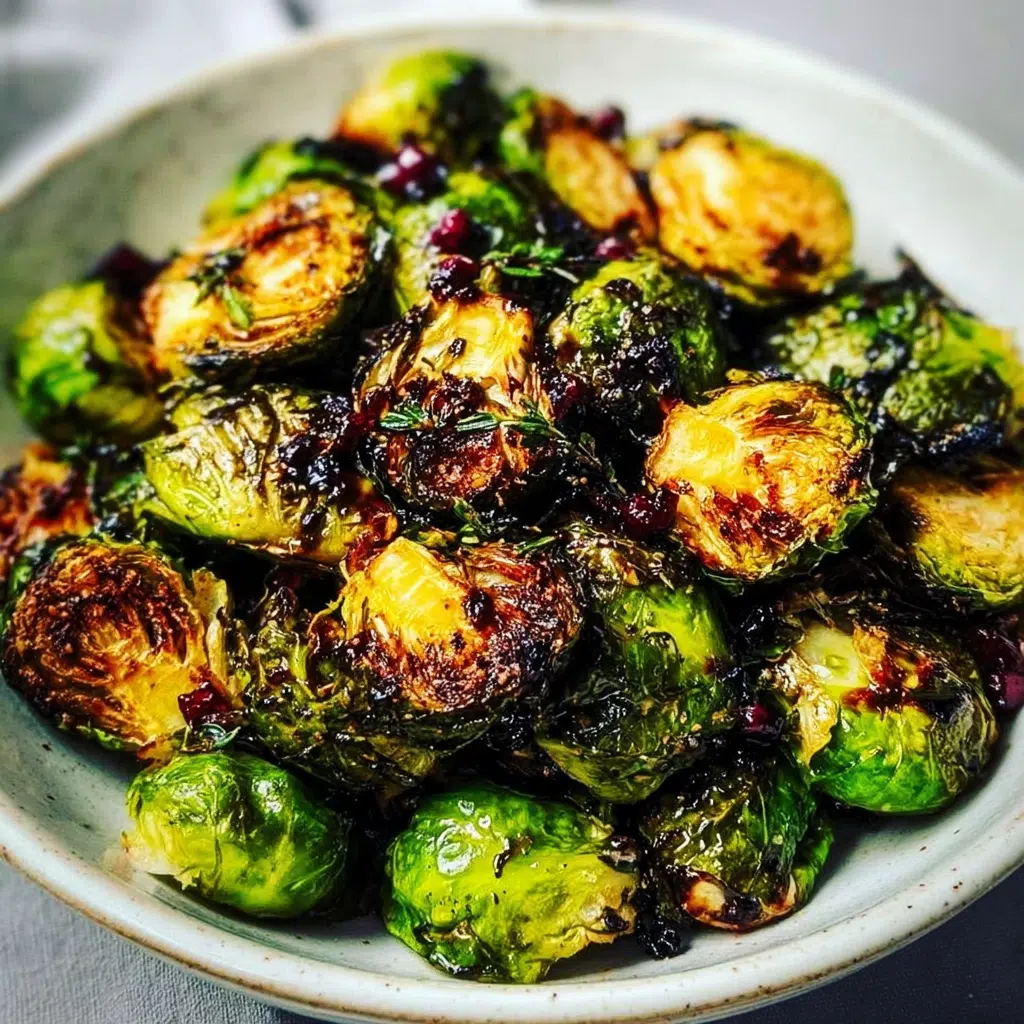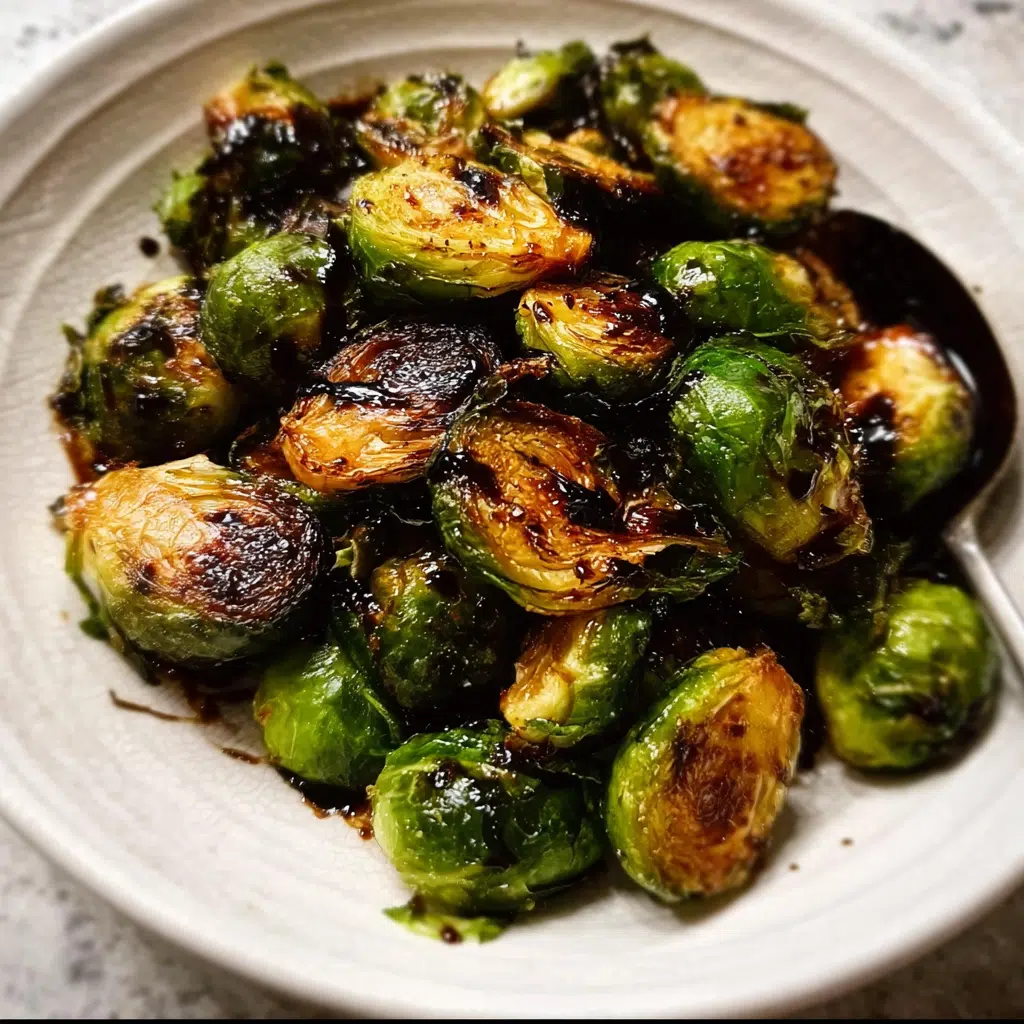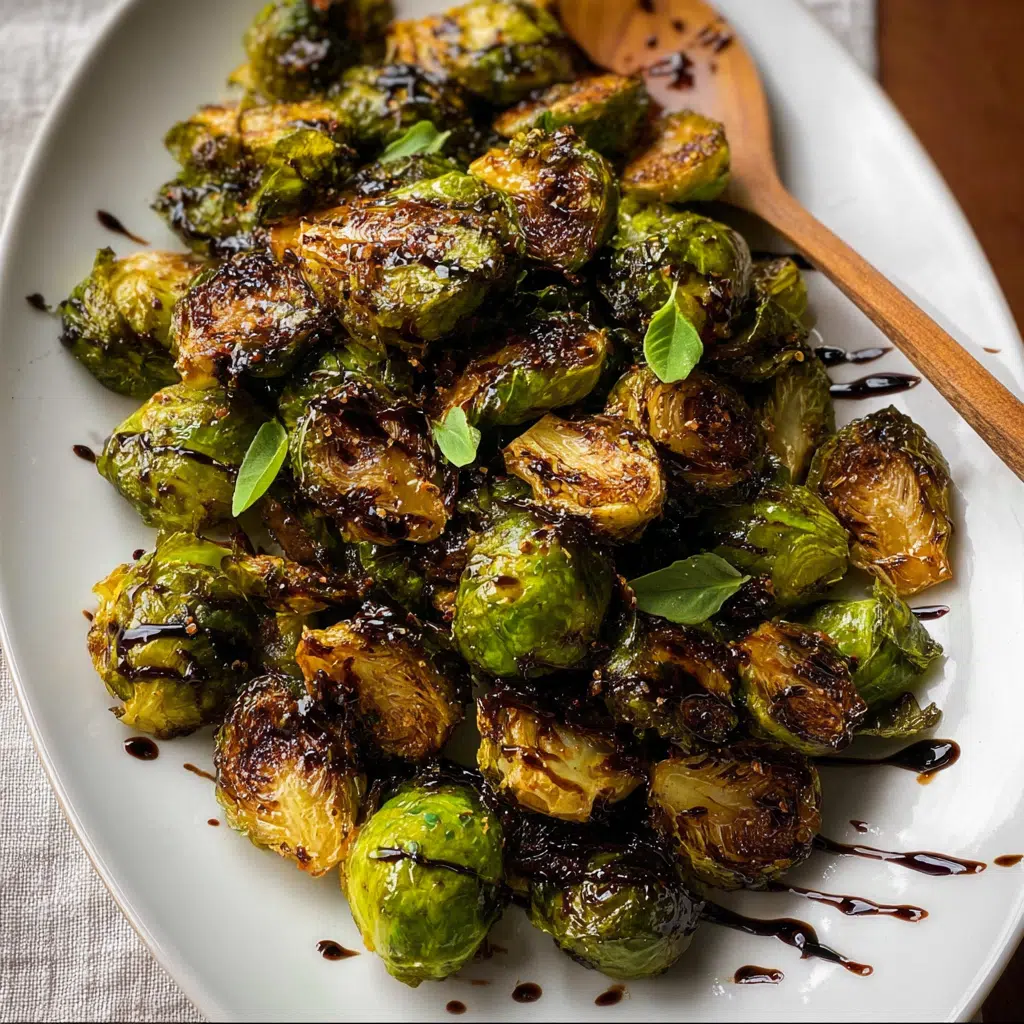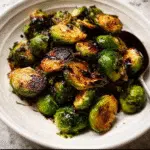Tired of mushy, bitter Brussels sprouts that make everyone at the dinner table cringe? I completely understand that struggle! As someone who once avoided these little green vegetables like the plague, I never imagined I’d become absolutely obsessed with creating the perfect Roasted Brussels Sprouts with Balsamic Glaze recipe. But here’s the incredible transformation story: after years of experimenting in my kitchen at Recipesrealm, I’ve discovered the secret to turning these humble vegetables into crispy, caramelized perfection that even the pickiest eaters will devour.
Hi there! I’m Lisa, the heart and soul behind Recipesrealm, and this Roasted Brussels Sprouts with Balsamic Glaze recipe has become one of my most requested dishes during family gatherings and dinner parties. What started as a personal mission to rehabilitate Brussels sprouts in my own kitchen has turned into a game-changing recipe that brings joy to tables everywhere. The magic happens when high heat meets the perfect balance of sweet balsamic glaze and crispy edges that develop during roasting.
This comprehensive guide will walk you through everything you need to know about creating restaurant-quality Roasted Brussels Sprouts with Balsamic Glaze at home. We’ll cover selecting the freshest Brussels sprouts, mastering the roasting technique for maximum crispiness, creating that perfect glossy balsamic reduction, and troubleshooting common mistakes that lead to disappointing results. Whether you’re preparing a weeknight side dish or an elegant holiday accompaniment, this recipe will become your go-to method for Brussels sprouts perfection.
Why This Roasted Brussels Sprouts with Balsamic Glaze Recipe Works
The genius behind this Roasted Brussels Sprouts with Balsamic Glaze lies in the perfect marriage of technique and flavor balance. After testing countless variations, I’ve discovered that success comes from understanding how heat transforms these vegetables from bitter to sweet, and how the right glaze elevates them from ordinary to extraordinary.
Here’s what makes this recipe absolutely foolproof:
• High-heat roasting creates the perfect textural contrast – The outer leaves become deliciously crispy and caramelized while the interior remains tender and sweet, eliminating that sulfurous bitterness that turns people away from Brussels sprouts
• Simple ingredients deliver maximum impact – Using just Brussels sprouts, olive oil, salt, pepper, and a homemade balsamic glaze, you’ll create complex flavors that taste like they came from a high-end restaurant kitchen
• Versatile enough for any occasion – Whether you’re serving a casual family dinner, hosting a holiday feast, or meal-prepping for the week ahead, this recipe adapts beautifully to any setting or serving size
• Quick preparation with impressive results – From start to finish, you’ll have restaurant-quality Brussels sprouts ready in under 45 minutes, making it perfect for both weeknight dinners and special occasions
Choosing the Right Brussels Sprouts for Roasted Brussels Sprouts with Balsamic Glaze
Selecting quality Brussels sprouts is absolutely crucial for achieving the perfect Roasted Brussels Sprouts with Balsamic Glaze. The difference between mediocre and magnificent results often comes down to the vegetables you choose before you even turn on your oven.
Best Brussels Sprouts for This Recipe
When shopping for Brussels sprouts for your Roasted Brussels Sprouts with Balsamic Glaze, look for small to medium-sized sprouts that feel firm and heavy for their size. The ideal Brussels sprouts should have tightly packed, bright green leaves without any yellowing or black spots. Smaller Brussels sprouts, typically 1 to 1.5 inches in diameter, roast more evenly and develop better caramelization than their larger counterparts.
Avoid Brussels sprouts that feel soft, have loose or wilted outer leaves, or show any signs of insect damage. Fresh Brussels sprouts should have a clean, slightly sweet aroma rather than any strong or unpleasant odors that might indicate age or poor storage conditions.
Buying Tips for Perfect Results
The best time to buy Brussels sprouts is during their peak season from September through February, when they’re at their sweetest and most flavorful. If possible, choose Brussels sprouts that are still attached to the stalk, as these tend to stay fresher longer than pre-cut individual sprouts.
When selecting pre-packaged Brussels sprouts, check the bottom of the container for any liquid accumulation, which indicates the vegetables may be past their prime. Look for packages with a recent harvest date, and don’t be afraid to gently shake the container – fresh Brussels sprouts should feel solid and not rattle around loosely.
Storage and Substitutions
Store your Brussels sprouts in the refrigerator’s crisper drawer in a perforated plastic bag, where they’ll maintain their quality for up to one week. Don’t wash them until you’re ready to use them, as excess moisture can lead to premature deterioration.
If you can’t find fresh Brussels sprouts, frozen ones can work in a pinch for this Roasted Brussels Sprouts with Balsamic Glaze recipe, though you’ll need to thaw and thoroughly dry them first. Keep in mind that frozen Brussels sprouts won’t achieve quite the same level of crispiness as fresh ones, but they’ll still deliver great flavor when properly prepared.

Ingredients & Prep for Roasted Brussels Sprouts with Balsamic Glaze
Creating perfect Roasted Brussels Sprouts with Balsamic Glaze starts with proper preparation and understanding how each ingredient contributes to the final dish. The beauty of this recipe lies in its simplicity, but attention to detail during the prep stage makes all the difference in achieving restaurant-quality results.
Brussels Sprouts Prep Essentials
Proper preparation is the foundation of exceptional Roasted Brussels Sprouts with Balsamic Glaze. Start by trimming the stem end of each Brussels sprout, removing just enough to eliminate any dry or tough portions while keeping the sprout intact. Remove any damaged or yellowed outer leaves, but don’t over-strip them as those outer leaves become deliciously crispy during roasting.
Cut each Brussels sprout in half lengthwise, creating flat surfaces that will caramelize beautifully against the hot pan. For larger Brussels sprouts, you may want to quarter them to ensure even cooking. After cutting, rinse the Brussels sprouts briefly in cold water and then thoroughly pat them dry with paper towels – this step is crucial for achieving maximum crispiness.
Allow the prepared Brussels sprouts to come to room temperature for about 15 minutes before roasting. This ensures more even cooking and better caramelization from the moment they hit the hot oven.
Balsamic Glaze Components
The star of this Roasted Brussels Sprouts with Balsamic Glaze is the homemade balsamic reduction that adds sweet, tangy depth to every bite. You’ll need:
• 1 cup high-quality balsamic vinegar – Choose a balsamic vinegar with rich, complex flavor rather than the cheapest option available • 2 tablespoons honey or maple syrup – This adds natural sweetness that balances the acidity • 1 clove minced garlic – Provides aromatic depth without overwhelming the delicate Brussels sprouts flavor • 1/4 teaspoon red pepper flakes – Optional, but adds a subtle heat that complements the sweetness beautifully
Essential Pantry Staples
For the roasting process, you’ll need premium extra virgin olive oil, which should have a fruity flavor that enhances rather than masks the Brussels sprouts. Use coarse sea salt or kosher salt for seasoning, as the larger crystals provide better texture and flavor distribution than table salt.
Freshly cracked black pepper is essential – pre-ground pepper simply doesn’t provide the same aromatic punch that elevates this Roasted Brussels Sprouts with Balsamic Glaze from good to extraordinary. Consider having fresh thyme or rosemary on hand for optional herb variations that add sophisticated flavor notes.
Step-by-Step Cooking Instructions for Roasted Brussels Sprouts with Balsamic Glaze
Mastering the technique for perfect Roasted Brussels Sprouts with Balsamic Glaze requires attention to timing, temperature, and proper layering of flavors. Follow these detailed steps to achieve consistently excellent results every single time.
Pre-Cooking Prep for Roasted Brussels Sprouts with Balsamic Glaze
Begin by preheating your oven to 425°F (220°C), which is the optimal temperature for achieving crispy exteriors and tender interiors in your Roasted Brussels Sprouts with Balsamic Glaze. Position your oven rack in the center position to ensure even heat distribution around the Brussels sprouts.
Prepare a large rimmed baking sheet by lining it with parchment paper, which prevents sticking and makes cleanup effortless. If you don’t have parchment paper, lightly oil the baking sheet instead, but parchment paper produces superior results.
Pat the prepared Brussels sprouts completely dry once more before seasoning. In a large mixing bowl, toss the halved Brussels sprouts with 3 tablespoons of extra virgin olive oil, ensuring each piece is evenly coated. Season generously with salt and freshly ground black pepper, using about 1 teaspoon of salt and 1/2 teaspoon of pepper per pound of Brussels sprouts.
Roasting Method for Roasted Brussels Sprouts with Balsamic Glaze
Arrange the seasoned Brussels sprouts on your prepared baking sheet in a single layer, placing them cut-side down. This positioning is crucial for achieving the caramelized edges that make Roasted Brussels Sprouts with Balsamic Glaze so irresistible. Don’t overcrowd the pan – if necessary, use two baking sheets to ensure proper spacing.
Roast the Brussels sprouts for 20-25 minutes, depending on their size, without moving them during the first 15 minutes. This allows the cut surfaces to develop a beautiful golden-brown caramelization. After 15 minutes, check for browning and give the pan a gentle shake to turn any Brussels sprouts that haven’t caramelized on their cut side.
Continue roasting for an additional 5-10 minutes until the Brussels sprouts are tender when pierced with a fork and the outer leaves are crispy and golden brown. The total roasting time should be 20-25 minutes for medium-sized Brussels sprouts.
Glaze Preparation for Roasted Brussels Sprouts with Balsamic Glaze
While the Brussels sprouts roast, prepare your balsamic glaze. In a small saucepan, combine 1 cup of balsamic vinegar with 2 tablespoons of honey and 1 minced garlic clove. Bring the mixture to a gentle boil over medium-high heat, then reduce the heat to low and simmer steadily.
The balsamic reduction will take approximately 15-20 minutes to reach the proper consistency for your Roasted Brussels Sprouts with Balsamic Glaze. You’ll know it’s ready when it coats the back of a spoon and has reduced by about two-thirds. The glaze should be syrupy but still pourable – it will thicken slightly as it cools.
Remove the glaze from heat and stir in the red pepper flakes if using. Set aside until the Brussels sprouts are finished roasting.
Final Assembly for Roasted Brussels Sprouts with Balsamic Glaze
Once your Brussels sprouts are perfectly roasted, remove them from the oven and immediately drizzle with the warm balsamic glaze while they’re still hot. The heat will help the glaze penetrate slightly into the Brussels sprouts and create a beautiful glossy coating.
Gently toss the glazed Brussels sprouts on the baking sheet to ensure even coating, then transfer to a serving platter. Serve your Roasted Brussels Sprouts with Balsamic Glaze immediately while they’re still warm and crispy for the best texture and flavor experience.
Pro Tips for Perfect Roasted Brussels Sprouts with Balsamic Glaze
After years of perfecting this Roasted Brussels Sprouts with Balsamic Glaze recipe, I’ve learned invaluable tricks that separate good results from absolutely spectacular ones. These professional techniques will elevate your Brussels sprouts from ordinary side dish to show-stopping centerpiece.
Avoiding Common Mistakes with Roasted Brussels Sprouts with Balsamic Glaze
The most common mistake when making Roasted Brussels Sprouts with Balsamic Glaze is overcrowding the baking sheet, which leads to steaming rather than roasting. Brussels sprouts need space around them to develop proper caramelization, so use multiple pans if necessary rather than cramming everything onto one sheet.
Another frequent error is adding the balsamic glaze too early in the cooking process. The sugars in the glaze will burn under high heat, creating bitter flavors that overpower the sweet, nutty taste you’re aiming for. Always apply the glaze after roasting is complete, while the Brussels sprouts are still hot enough to absorb the flavors.
Don’t skip the drying step after washing your Brussels sprouts. Excess moisture creates steam in the oven, preventing the crispy texture that makes this Roasted Brussels Sprouts with Balsamic Glaze recipe so addictive.
Essential Tool Recommendations for Roasted Brussels Sprouts with Balsamic Glaze
A large, heavy-duty rimmed baking sheet is crucial for even heat distribution and preventing warping under high temperatures. Light-colored pans work best as they won’t over-brown the bottom of your Roasted Brussels Sprouts with Balsamic Glaze before the tops are properly caramelized.
Invest in a good quality small saucepan with a heavy bottom for making the balsamic glaze. Thin-bottomed pans can cause hot spots that may burn your reduction before it reaches the proper consistency.
A large mixing bowl is essential for properly tossing the Brussels sprouts with oil and seasoning. Don’t try to do this step directly on the baking sheet – you won’t achieve even coating, and you’ll likely end up with some Brussels sprouts that are over-seasoned while others remain bland.
Storage and Reheating for Roasted Brussels Sprouts with Balsamic Glaze
While Roasted Brussels Sprouts with Balsamic Glaze are best enjoyed fresh from the oven, leftovers can be stored in the refrigerator for up to 3 days in an airtight container. The texture will soften somewhat, but the flavors actually develop and intensify overnight.
For reheating, avoid the microwave, which will make your Brussels sprouts soggy. Instead, spread leftover Roasted Brussels Sprouts with Balsamic Glaze on a baking sheet and reheat in a 350°F oven for 5-7 minutes until warmed through and slightly re-crisped.
If you want to prep ahead, you can roast the Brussels sprouts without the glaze up to one day in advance, then reheat and add fresh glaze just before serving for the best results.
Flavor Variations for Roasted Brussels Sprouts with Balsamic Glaze
One of the most exciting aspects of mastering Roasted Brussels Sprouts with Balsamic Glaze is discovering how easily you can customize the basic recipe to suit different tastes and dietary preferences. These variations maintain the core techniques while introducing exciting new flavor profiles.
Spicy Twist on Roasted Brussels Sprouts with Balsamic Glaze
Transform your Roasted Brussels Sprouts with Balsamic Glaze into a fiery side dish by incorporating carefully selected heat elements that complement rather than overpower the sweet-tangy balance. Add 1/2 teaspoon of red pepper flakes directly to the Brussels sprouts before roasting, or for more intense heat, include 1/4 teaspoon of cayenne pepper in your seasoning mix.
For a smoky heat variation, substitute smoked paprika for regular black pepper, using about 1/2 teaspoon per pound of Brussels sprouts. This creates a complex flavor profile that pairs beautifully with the balsamic glaze’s sweetness. You can also add a pinch of chipotle powder to the glaze itself for subtle warmth that builds gradually.
Consider finishing your spicy Roasted Brussels Sprouts with Balsamic Glaze with a sprinkle of fresh chopped jalapeños or a few drops of high-quality hot sauce drizzled over the glazed vegetables just before serving.

Keto and Paleo Adaptations
Adapting Roasted Brussels Sprouts with Balsamic Glaze for keto and paleo lifestyles requires minimal modifications while maintaining all the flavors you love. Replace the honey in the balsamic glaze with sugar-free maple syrup or a keto-friendly sweetener like erythritol, using about 1 tablespoon instead of 2 tablespoons of honey.
For strict paleo adherence, pure maple syrup works beautifully in place of honey, though it will add slightly different flavor notes to your Roasted Brussels Sprouts with Balsamic Glaze. The natural fructose in maple syrup caramelizes similarly to honey, maintaining the glaze’s proper consistency and sweetness level.
Both adaptations work seamlessly with the basic roasting technique, so you won’t need to adjust cooking times or temperatures to accommodate these dietary modifications.
Global Flavor Inspirations
Mediterranean-style Roasted Brussels Sprouts with Balsamic Glaze comes alive with the addition of crumbled feta cheese, toasted pine nuts, and fresh herbs like oregano or thyme scattered over the finished dish. Add these elements after roasting but before applying the glaze for the best integration of flavors.
For an Asian-inspired twist, create a glaze using rice vinegar instead of balsamic, combined with soy sauce, honey, and a touch of sesame oil. Finish with toasted sesame seeds and thinly sliced green onions for a Roasted Brussels Sprouts with Balsamic Glaze variation that pairs perfectly with grilled meats or rice dishes.
| Variation Style | Key Ingredients | Flavor Profile | Best Paired With |
|---|---|---|---|
| Classic Balsamic | Traditional balsamic, honey | Sweet-tangy, caramelized | Roasted meats, holiday dinners |
| Spicy Heat | Red pepper flakes, cayenne | Warm heat with sweet finish | Grilled chicken, casual dinners |
| Mediterranean | Feta, pine nuts, oregano | Herbaceous, salty-sweet | Lamb, Mediterranean spreads |
| Asian Fusion | Rice vinegar, soy sauce, sesame | Umami-rich, nutty | Stir-fries, Asian-inspired meals |
| Keto-Friendly | Sugar-free sweetener, extra herbs | Clean, herb-forward | Low-carb mains, healthy eating |
Serving Suggestions for Roasted Brussels Sprouts with Balsamic Glaze
The versatility of Roasted Brussels Sprouts with Balsamic Glaze makes it an ideal companion for countless main dishes and occasions. Understanding how to pair this side dish effectively will help you create memorable meals that showcase the Brussels sprouts while complementing your entire menu.
Perfect Main Dish Pairings for Roasted Brussels Sprouts with Balsamic Glaze
Roasted Brussels Sprouts with Balsamic Glaze pairs exceptionally well with roasted chicken, where the caramelized vegetables complement the crispy skin and juicy meat. The sweet-tangy glaze provides a beautiful contrast to herb-crusted chicken thighs or a simple roasted whole bird.
For red meat lovers, this side dish creates magic alongside grilled or roasted beef. The balsamic glaze echoes traditional steak accompaniments while the Brussels sprouts add a sophisticated vegetable element that cuts through rich, fatty cuts. Try serving your Roasted Brussels Sprouts with Balsamic Glaze with prime rib, ribeye steaks, or slow-roasted beef tenderloin.
Fish and seafood also benefit from this pairing, particularly salmon, which shares the Brussels sprouts’ ability to handle bold flavors. The glaze’s acidity brightens the fish while the roasted vegetables add textural interest and earthy depth to the plate.
Complementary Side Dishes
When building a complete meal around Roasted Brussels Sprouts with Balsamic Glaze, consider sides that provide textural and flavor contrasts. Creamy mashed potatoes offer a smooth, rich counterpoint to the crispy Brussels sprouts, while the balsamic glaze adds brightness that prevents the combination from feeling heavy.
Wild rice pilaf or herbed quinoa provides nutty, chewy textures that harmonize beautifully with the caramelized Brussels sprouts. These grain-based sides also help absorb any extra glaze, ensuring no flavor goes to waste.
For lighter options, consider serving your Roasted Brussels Sprouts with Balsamic Glaze alongside simple arugula or spinach salads dressed with lemon vinaigrette, which echoes the acidic elements in the balsamic while providing fresh contrast.
Holiday and Special Occasion Presentations
During holiday gatherings, Roasted Brussels Sprouts with Balsamic Glaze can be elevated into a stunning centerpiece side dish. Transfer the finished Brussels sprouts to a beautiful serving platter and garnish with pomegranate seeds for color contrast and subtle tartness that complements the balsamic glaze.
For elegant dinner parties, consider serving individual portions in small cast-iron skillets or ceramic ramekins, drizzling each serving with fresh glaze just before presenting to guests. This presentation maintains the ideal temperature while creating an upscale restaurant experience.
Adding toasted nuts like pecans, walnuts, or hazelnuts provides textural interest and rich flavors that enhance the sophisticated nature of Roasted Brussels Sprouts with Balsamic Glaze for special occasions.

FAQs About Roasted Brussels Sprouts with Balsamic Glaze
Understanding common challenges and questions about Roasted Brussels Sprouts with Balsamic Glaze will help you achieve consistent success and troubleshoot any issues that arise during preparation. These frequently asked questions address the most common concerns home cooks encounter.
Can I Use Frozen Brussels Sprouts for Roasted Brussels Sprouts with Balsamic Glaze?
While fresh Brussels sprouts produce superior results, frozen Brussels sprouts can work for Roasted Brussels Sprouts with Balsamic Glaze with proper handling. Thaw frozen Brussels sprouts completely and pat them extremely dry with paper towels, removing as much moisture as possible to prevent steaming during roasting.
Frozen Brussels sprouts may require slightly longer cooking times, typically an additional 5-10 minutes, to achieve proper caramelization. The texture won’t be quite as crispy as fresh Brussels sprouts, but you’ll still achieve delicious results with proper preparation and patience.
Consider increasing the oven temperature to 450°F when using frozen Brussels sprouts to help drive off excess moisture more quickly and promote better browning in your Roasted Brussels Sprouts with Balsamic Glaze.
How Do I Fix Overcooked Brussels Sprouts?
If your Brussels sprouts become mushy or overcooked, there are several recovery strategies for your Roasted Brussels Sprouts with Balsamic Glaze. Remove them from heat immediately and spread them on a cool baking sheet to stop the cooking process.
While you can’t restore the crispy texture completely, you can salvage overcooked Brussels sprouts by pureeing them into a smooth side dish with butter and cream, or incorporating them into soups and stews where the softer texture is appropriate.
For future batches, reduce cooking time by 5-10 minutes and check for doneness more frequently during the final stages of roasting your Roasted Brussels Sprouts with Balsamic Glaze.
Is This Recipe Safe During Pregnancy?
Roasted Brussels Sprouts with Balsamic Glaze is generally safe and nutritious during pregnancy, providing excellent sources of folate, vitamin C, and fiber that support maternal and fetal health. Brussels sprouts are particularly beneficial during pregnancy due to their high folate content, which helps prevent birth defects.
The balsamic glaze poses no safety concerns when properly prepared and cooked, as any alcohol content in the vinegar evaporates during the reduction process. However, pregnant women should ensure Brussels sprouts are thoroughly cooked and consume them as part of a balanced diet.
Always consult with your healthcare provider about dietary choices during pregnancy, but Roasted Brussels Sprouts with Balsamic Glaze typically fits well within recommended nutritional guidelines for expecting mothers.
How Long Does Balsamic Glaze Keep?
Homemade balsamic glaze for your Roasted Brussels Sprouts with Balsamic Glaze can be stored in the refrigerator for up to 2 weeks in a sealed container. The glaze will thicken when cold but can be gently rewarmed before using or allowed to come to room temperature.
For longer storage, balsamic glaze freezes well for up to 3 months in ice cube trays, allowing you to thaw individual portions as needed for future batches of Roasted Brussels Sprouts with Balsamic Glaze.
The acidity in balsamic vinegar acts as a natural preservative, but always check for any signs of mold or off odors before using stored glaze, and discard if you notice any changes in appearance or smell.
Conclusion
Creating perfect Roasted Brussels Sprouts with Balsamic Glaze has become one of my greatest kitchen victories, transforming a once-maligned vegetable into a dish that consistently earns rave reviews from family and friends. Through years of testing and refinement at Recipesrealm, I’ve discovered that the secret lies not in complex techniques or exotic ingredients, but in understanding how simple elements work together to create extraordinary results.
The magic happens when fresh Brussels sprouts meet high heat, creating those irresistible caramelized edges while maintaining tender interiors. The homemade balsamic glaze adds the perfect sweet-tangy finish that elevates these humble vegetables into restaurant-quality sophistication. Whether you’re serving them as a weeknight side dish or presenting them at your next holiday gathering, this Roasted Brussels Sprouts with Balsamic Glaze recipe delivers consistency and flavor that will make believers out of even the most skeptical Brussels sprouts doubters.
Remember that cooking is about creating memories and sharing moments, and this recipe embodies everything I love about bringing people together around the dinner table. The satisfaction of watching someone take their first bite of perfectly roasted Brussels sprouts and seeing their face light up with surprise and delight never gets old.
Fire up your oven and try this Roasted Brussels Sprouts with Balsamic Glaze tonight! Join the thousands of home cooks who’ve discovered that Brussels sprouts can be absolutely delicious when prepared with care and attention to technique. Once you master this recipe, you’ll find yourself reaching for Brussels sprouts regularly, knowing you can transform them into something truly special.
Don’t forget to explore our other roasted vegetable guides and seasonal side dish collections at Recipesrealm – there’s a whole world of vegetable possibilities waiting to be discovered in your kitchen!
If you loved this recipe, don’t forget to share it with your friends or save it to try later! I’d be thrilled to see your personal touch—share your photos on Pinterest
Print

